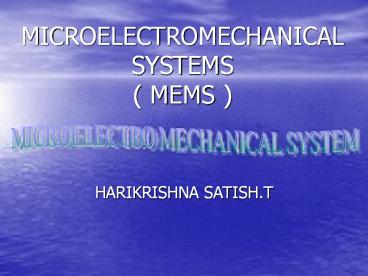MICROELECTROMECHANICAL SYSTEMS ( MEMS ) - PowerPoint PPT Presentation
Title:
MICROELECTROMECHANICAL SYSTEMS ( MEMS )
Description:
MICROELECTROMECHANICAL SYSTEMS ( MEMS ) HARIKRISHNA SATISH.T Introduction: MEMS stands for Micro-electromechanical systems, a manufacturing technology that enables ... – PowerPoint PPT presentation
Number of Views:335
Avg rating:3.0/5.0
Title: MICROELECTROMECHANICAL SYSTEMS ( MEMS )
1
MICROELECTROMECHANICAL SYSTEMS( MEMS )
MICROELECTRO MECHANICAL SYSTEM
- HARIKRISHNA SATISH.T
2
Introduction
- MEMS stands for Micro-electromechanical systems,
a manufacturing technology that enables the
development of electromechanical systems using
batch fabrication techniques similar to those
used in integrated circuit (IC) design. - They can range in size from micrometers to
millimeters - MEMS integrate mechanical elements, sensors,
actuators and electronics on a silicon substrate
using a process technology called micro
fabrication. - Micro electro mechanical System (MEMS) is making
and combining of miniaturized mechanical and
electrical components on a common silicon
substrate through micro fabrication technology.
3
How MEMS work?
- The sensors gather information by measuring
mechanical, thermal, biological, chemical,
magnetic and optical signals from the
environment. - The microelectronic Ics act as the
decision-making piece of the system, by
processing the information given by the sensors. - Finally, the actuators help the system respond by
moving, pumping, filtering or somehow controlling
the - surrounding environment to achieve its
purpose.
4
Manufacturing process
5
- The MEMS materials
- Primarily silicon its compounds
- other materials are quartz crystal, glass, metals
such as aluminum, titanium, tungsten and copper - polymers such as photo resist.
- What is Micromachining ?
- Micromachining is a parallel (batch) process in
which dozens to tens of thousands of identical
elements are fabricated simultaneously on the
same wafer. - Divided into three major categories basic,
advanced, and nonlithographic processes.
6
- Basic process flow in micromachining
Figure Illustration of the basic process flow
in micromachining Layers are deposited
photoresist is lithographically patterned and
then used as a mask to etch the underlying
materials. The process is repeated until
completion of the microstructure.
7
BASIC PROCESS TOOLSDeposition ProcessEpitaxy
Epitaxy is a deposition method to grow a
crystalline silicon layer over a silicon wafer,
but with a differing dopant type and concentration
Impurity dopants AsH3 PH3 (Controlled)
MICROELECTROMECHANICAL SYSTEM
Silicon Contain source gas SiH4/SiCl4/SiH2Cl2
High Temperature ( )
Controlled
Wafer Scale p-n junction for Controlled
electrochemical etching
8
Oxidation High-quality amorphous silicon dioxide
is obtained by oxidizing silicon in eitherdry
oxygen or in steam at elevated temperatures
(850º1,150ºC)
- Si O2/ Steam
SiO2 - It is Depend on Temperature , Oxidizing
environment and Time. - Sputter Deposition
9
Evaporation
- Heated at high
Temperature -
(Scanning at high voltage electronic beam) -
(Water cooling of the target and -
shielding from X-ray)
Al , Si, Ti,Cr , Al2O3
Evaporation
Condenses on a substrate to form a film
10
CVD (Chemical Vapour Deposition)
- Deposition Of Polysilicon -
- SiH4
Si
2H2 - Polysilicon may be grown directly with doping.
- Deposition of Silicon dioxide -
- SiH4 O2
SiO2 2H2 - SiCl2H2 2N2O
SiO2 2N2
2HCl - Si(OC2H5)4 2N2O
SiO2 byproduct
25 p.a -150 p.a In CVD Chamber
High temperature
Oxide
Doped
Semiconductor
Impurity P2O5
11
Deposition of Silicon Nitrides
- 3SiH4 NH3
Si3N4
12H2 - 3SiCl2H2 4NH3
Si3N4 6HCl 6H2 - 2SiH4 N2
2SiNH
3H2 - SiH4 NH3
SiNH 3H2 - Silicon nitride is common in the semiconductor
industry for the passivation of electronic
devices because it forms an excellent protective
barrier against the diffusion of water and sodium
ions
12
Photolithography
Photosensitive material
Selectively expose to Light
Exposed part (physical property change)
Non-exposed part (remain same in physical
properties)
Perform Etching
Deposition of metal or other thin film deposition
13
Etching In etching, the objective is to
selectively remove material using imaged
photoresist as a masking template.
- Wet Etching -
- Anisotropic Wet Etching
Dipped into
Removal of material Depending on
the Crystallographic orientation
Substrate
KOH Solution
14
Electrochemical Etching
15
Reactive Ion Etching ( RIE )
- Process of reactive ion etching.
Placed into
Substrate
Reactor contain several gas
Plasma is struck in the mixture
Gas molecule into ions
React with the surface of the material and etched
16
Deep Reactive Ion Etching ( DRIE )
SF6 isotopic Etching (SF6 O2 etches the
substrate)
C4F8 deposition
SF6 anisotropic etching for floor cleaning
17
- Using these processes some micromachining
methods are applied on silicon materials are - A) Bulk micromachining Bulk micromachining
designates the point at which the bulk of the Si
substrate is etched away to leave behind the
desired micromechanical elements. The methods
commonly used to remove excess material are wet
and dry etching, allowing varying degree of
control on the profile of the final structures. - B) Surface Micromachining The MEMS fabrication
process based on standard CMOS microelectronic
processes. MEMS structures are photo
lithographically patterned in alternating layers
of deposited polysilicon and silicon dioxide, and
then are "released" by dissolving away the
silicon dioxide layers.
18
Applications of MEMS
- inkjet-printer cartridges,
- accelerometer,
- miniature robots,
- micro engines,
- inertial sensors,
- micro actuators,
- optical scanners,
- fluid pumps,
- chemical, pressure and flow sensors.
- Application in Radio frequency (RF)
19
Reference -
- By Maluf Nadim and Williams Kirt .
- An Introduction to Microelectromechanic
al Systems Engineering. - By committee on Advanced Material and
Fabrication. - Microelectromechanical Systems.
- The MEMS Handbook.
20
- Thank You































